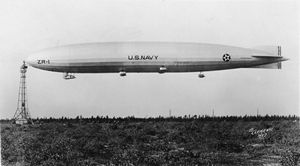Catalogue number 124064
U.S.S. Shenandoah, ZR-1
ZR-1 is shown at its mooring tower in Lakehurst and made it first flight in 1923. She was designed to be inflated with hydrogen but considering the fire risk, the then rare and costly helium was used instead. To counteract the loss in buoyancy and reduce weight, several manoeuvring valves and automatic gas release valves were removed, hence conserving the helium charge. Possibly as a result of these modifications, U.S.S. Shenandoah crashed on 3rd September 1925 after being caught in a violent updraught and ascended before correction of gas pressure could be made with the remaining valves. At too high an altitude, the gas bags were torn apart when their pressure limits were exceeded.
Credit: Clements
23.4cm x 13cm Gelatin silver print
|
 |